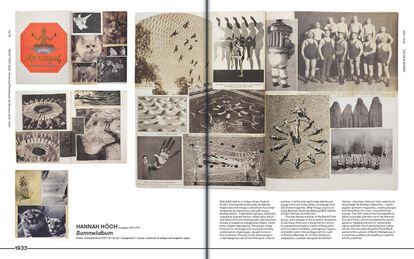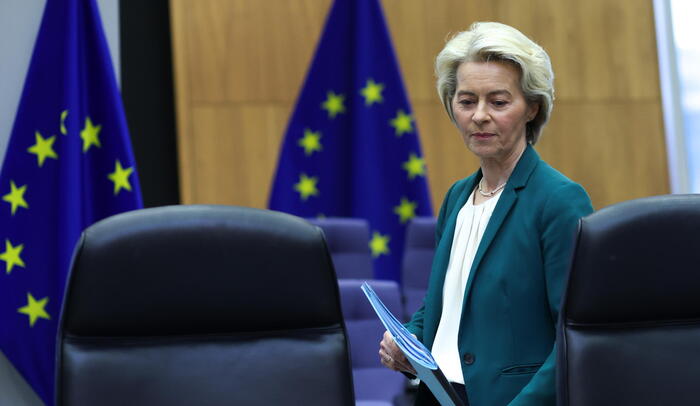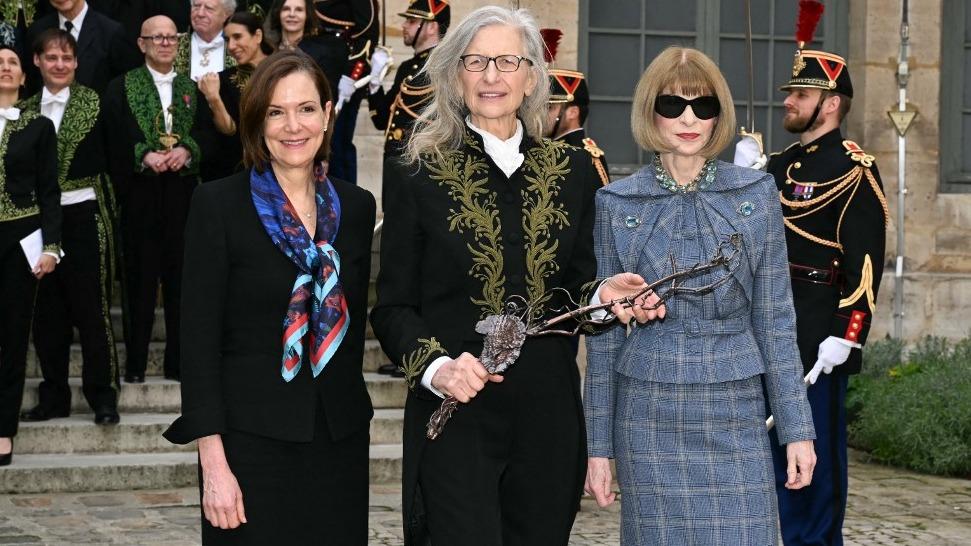In 1843, the artist and botanist Anna Atkins began the publication of
Photographs of British Algae: Cyanotype Impressions
(1843-53)
, a series of fascicles that, over a decade, shaped what is now recognized as the first book printed and illustrated with photographs.
The British author was eight months ahead of the publication of
The Pencil of Nature,
by the polymath William Henry Fox Talbot,
who until the last decade of the eighties has figured as the first author of what today we would describe as a photobook. However, for more than a century the photographer remained in the dark (her initials, AA, often came to be interpreted as Amateur Anonymous) and would probably have remained there were it not for the investigations carried out by the historian Larry J. Schaaf, who apart from rescuing the figure of the author, in 2015 was able to confirm that
The Quillian Leaf ,
one of the first photographic images preserved, attributed until then, and again, to Fox Talbot, was the work of another woman Sarah Anne Bright. The beginnings of the history of this influential medium that would change the look of the world were rewritten.
'Armavir, Yervandashat', 2002, from the series 'Bus stops in Armenia', 1996–2004, by Ursula Schulz-DornburgImage, from the book 'Photography- A Feminist History', by Emma Lewis, published by Octopus Books/Tate .
There is a tendency to focus our gaze on certain parts of the world and on notable individuals who have shaped or documented history, while ignoring the contributions of others who remain invisible. For every Atkins or Bright, how many other female photographers have been eliminated from the discourse of history? How many have seen their lackluster biographies as mere appendices to the men with whom they shared their lives? From different positions, women have contributed to all aspects of the development of the short history of the photographic medium, a feat that two recent publications coincide in underlining from different perspectives:
What They Saw: Historical Photobooks by Women, 1843-1999
(10x10 Photobooks) , edited by Russet Lederman and Olga Yatskevich and
Photography - A Feminist History
(Octopus Books/Tate), by Emma Lewis.
Paradoxically, we could apply the saying to both books: “Not all of them are, nor are all of them”.
Inevitably, many slip under the radar of history, but women do so far more often.
Page from 'What They Saw: Historical Photobooks by Women, 1843-1999', edited by Russet Lederman and Olga Yatskevich and published by 10X10 Photobooks, NYC.
In
What They Saw: Historical Photobooks by Women, 1843-1999
,
the authors put together an anthology that traces the history of photobooks created by women from 1843 to 1999. The book has won the Best Catalog of the Year award at the last Paris Photo edit. An exercise in revisionism that is much needed in this expansive age of the photobook, whose very history has begun to pay attention relatively recently. It was the Spanish historian Horacio Fernández who opened the gap with
Public Photography/Photography in Print 1919-1939
, a study that accompanied an exhibition at the Reina Sofía with the title of the same name in 1999. Among the books that followed, the most popular were
The Book of 101 Books,
by Andrew Roth, and the three volumes that make up
The Photobook: A History,
signed by Gerry Badge and Martin Parr. The American critic Jorg Colberg pointed out in one of his writings that in the first volume of this trilogy there are only 18 books signed by women among a total of 209. The second volume improves to add 37 female photographers among the 174 authors. "There are other books of books, delimited by specific geographic areas or themes," Yatskevich points out. “In all of them, the reduced space dedicated to publications signed by women was manifest. This was the data that gave way to our first project:
How We See. Photobooks by Women
, published in 2018, for which ten curators chose and wrote about 10 women's photobooks.
From there we launched this latest publication, in which we have tried to bring to light books that had been relegated to oblivion.
'Cutout', 2017, from the series 'The dream is wonderful, but imprecise', 2014-20, by Maria Kapajeva.
Image from the book 'Photography- A Feminist History', by Emma Lewis, published by Octopus Books/Tate.
For such a wide-ranging task, the authors contacted curators, librarians, publishers, and collectors. Among his discoveries, Yatskevich highlights Alice Seeley Harris's
The Camera and The Congo Crime
. Published at the beginning of the 20th century, it can be considered an example of a photographic humanitarian campaign during which the author documented the atrocities committed under the reign of Leopold II. He also cites
One Time, One Place,
published in 1971, four decades after its completion. Its author is the well-known American writer Eudora Welty, who documented life in Mississippi, her homeland, during the mid-1930s.
Passion
offers a gallery of portraits, published in 1989, where the Cameroonian photographer Angèle Etoundi Essamba defies stereotypes.
Divided into ten thematic chapters, which place the books within the social, political and cultural context of the moment, the publication also includes photobooks by authors who are already part of the pantheon of masters of photography, such as Diane Arbus, Margaret Burke-White , or Varvara Stepanova.
We will also find a benchmark in the history of photography in our country,
Spain Hidden
,
by Cristina García Rodero, the first great photoethnological study of the festivals and traditions of Spain, as well as
Antifémina
,
by Colita, a manifesto that proposes a representation of the most diverse woman.
'Self-Portrait, (New Woman)', 1896, by Francis Benjamin Johnson. Image from the book 'Photography- A Feminist History', by Emma Lewis, published by Octopus Books/Tate."Library of Congress; P&P"
"As we progressed in our research, we had to expand the definition of the photobook that we initially considered," explains Yatskevich.
“Thus we went on to include personal albums such as Arabella Chapman's, clippings, portfolios, pamphlets, to cover the works made in the early years of photography, when women did not have access to the different printing mechanisms, nor did they have economic resources.
Many of the books that we have found are really incredible and show the ability of these women to overcome the great obstacles they encountered in their realization.
The wide variety of topics they cover is enormous.”
The history of photography has passed in parallel to the history of feminism. In 1939, the year the daguerreotype was presented at the Academy of Sciences in Paris, the philosopher Charles Fourier coined the term feminism. A path that travels
Photography - A Feminist History
. “One of the tasks of feminism is, to paraphrase the American writer Rebecca Solnit, to make women believable and audible, and photography has made both possible,” writes Lewis, curator of the Tate Gallery, in the book's introduction. The volume presents 140 photographers, from different parts of the world, who, from the practice of studio photography carried out at the beginning of the medium until the days of Instagram, have delved into what it means to be a woman from different positions. Thus we find authors who shy away from the concept of the female gaze and others who place their condition as women at the heart of their art. Women who were sometimes marginalized in favor of the few who managed to enter history.Artists who often do not fit into molds and stereotypes and who find their voice through photography. The book explores the way in which women photographers have documented the political and social changes of women and how feminism, within its broad definition, has offered us new ways of understanding images.
'
What They Saw: Historical Photobooks by Women, 1843-1999
'.
Russet Lederman and Olga Yatskevitch.
352 pages.
75 euros.
'
Photography- A Feminist History
'.
Emma Lewis.
Octopus Books / Tate.
225 pages.
48 euros.
You can follow BABELIA on
and
, or sign up here to receive
our weekly newsletter
.
Sign in to continue reading
Just by having an account you can read this article, it's free
RegisterLogin
Thanks for reading THE COUNTRY


/cloudfront-eu-central-1.images.arcpublishing.com/prisa/BJP24JNYMRDX3JV4YKTWR4PEWY.jpg)



/cloudfront-eu-central-1.images.arcpublishing.com/prisa/BRRQWHKHTBFDJJ6EREN2ZD5LLE.png)


/cloudfront-eu-central-1.images.arcpublishing.com/prisa/HXTIXWY4CZBOVEEG4LB5KEE354.jpg)